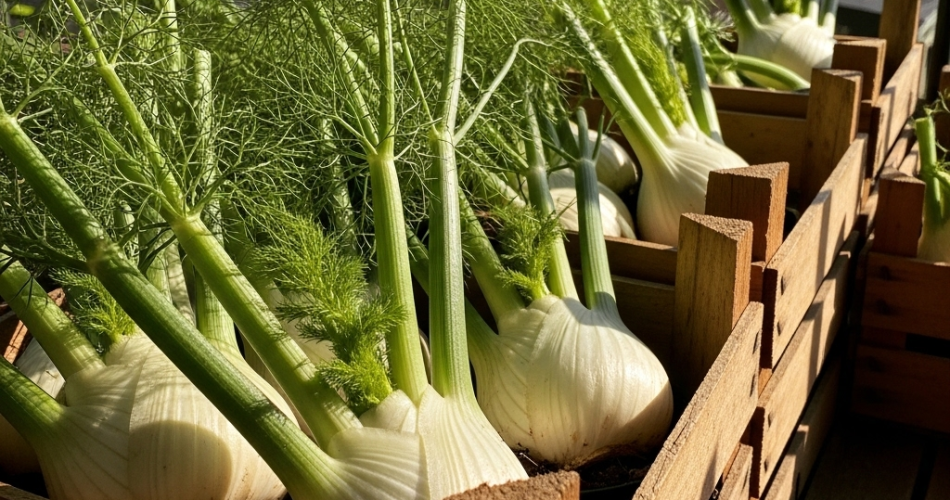Fennel (Foeniculum vulgare) is a fragrant and flavorful herb valued for its crunchy bulbs, feathery fronds, and slightly sweet taste. From salads and soups to roasted dishes and herbal teas, fennel adds both aroma and culinary depth to meals. For gardeners with limited space, growing fennel in balcony crates is a practical solution, allowing you to cultivate this versatile herb even without a traditional garden.
Crate gardening provides an efficient way to maximize vertical and horizontal space on balconies or patios. Using crates also allows for better control over soil, drainage, and sunlight exposure, ensuring that fennel plants thrive in a confined area.
Choosing Crates and Preparing Your Balcony
Select a sturdy crate that can hold soil without warping under the weight of water. Wooden fruit or vegetable crates are ideal, while plastic crates offer durability and easy cleaning. Ensure your chosen crate has proper drainage by drilling small holes at the bottom to prevent water accumulation, which can harm fennel roots.
Position the crate in a sunny spot on your balcony. Fennel thrives in full sunlight, requiring at least 6 hours of direct light daily. South- or west-facing balconies are ideal. Elevating the crate on a plant stand or balcony railing can enhance air circulation and make harvesting more convenient.
Preparing Soil for Fennel
Fennel grows best in fertile, well-draining soil. Use a high-quality potting mix enriched with organic compost to provide essential nutrients. Avoid dense garden soil, which can compact in crates and restrict root expansion.
For optimal drainage, add a thin layer of small stones or gravel at the bottom of the crate. Fill the remaining space with potting mix, leaving a small gap at the top for watering and mulching. Proper soil preparation ensures healthy bulb formation and lush fronds.
Planting Fennel in Crates
Fennel can be grown from seeds or nursery plants:
-
From seeds: Sow seeds 0.5–1 cm deep and keep the soil consistently moist until germination, typically within 7–14 days. Thin seedlings to prevent overcrowding and support strong growth.
-
From nursery plants: Transplant young fennel plants into the crate, spacing them adequately to allow airflow and prevent competition for nutrients. Firm the soil around the roots and water thoroughly.
Proper spacing is essential to allow the bulbs to develop fully and ensure good air circulation, reducing the risk of disease.
Watering and Maintenance
Fennel prefers evenly moist soil but does not tolerate standing water. Water when the top 2–3 cm of soil feels dry, making sure excess water drains freely from the crate. Balcony crates can dry out faster than ground containers, so regular monitoring is important, especially in hot weather.
Mulching with a light layer of compost helps retain moisture, regulate soil temperature, and suppress weeds. Avoid wetting the foliage excessively to reduce the risk of fungal diseases.
Sunlight Requirements
Full sun is key to producing healthy fennel bulbs and vibrant fronds. Ensure your balcony crate receives at least 6 hours of direct sunlight per day. If sunlight is limited, supplement with a grow light to encourage upright growth and strong flavor. Proper light exposure helps prevent spindly stems and enhances the sweetness of the bulbs.
Fertilizing Crate-Grown Fennel
Container-grown fennel benefits from regular feeding. Use a balanced liquid fertilizer every 3–4 weeks or incorporate slow-release organic fertilizer into the soil at planting. Organic options, such as compost tea or fish emulsion, provide nutrients while improving soil structure and flavor.
Avoid excessive nitrogen, which may promote leafy growth at the expense of bulb development. Consistent fertilization ensures strong roots, thick bulbs, and flavorful fronds.
Harvesting Fennel
Fennel bulbs are ready to harvest when they reach 7–10 cm in diameter and feel firm to the touch. Cut bulbs at soil level, leaving roots intact to encourage regrowth. Feathery fronds can be trimmed continually for culinary use or decorative purposes.
Regular harvesting promotes bushier plants, maintains bulb quality, and ensures a continuous supply of fresh fennel. Freshly harvested bulbs and fronds can be used immediately or stored in the refrigerator for several days.
Tips for a Thriving Balcony Fennel Crate Garden
-
Rotate crates occasionally for even sunlight exposure.
-
Remove yellow or damaged leaves to maintain plant health.
-
Monitor for pests, such as aphids or caterpillars, and manage with natural methods.
-
Ensure crates are stable and securely placed to prevent accidents.
Final Thoughts
A balcony crate garden makes growing fennel accessible to anyone, even without a traditional yard. This method maximizes limited space, allows precise control over soil and watering, and provides a steady supply of flavorful bulbs and aromatic fronds.
With proper soil, consistent watering, sufficient sunlight, and regular harvesting, your balcony fennel crate garden will thrive. This approach transforms a small balcony into a productive, fragrant, and visually appealing herb garden, putting fresh fennel literally at your fingertips.



